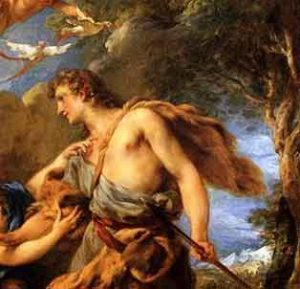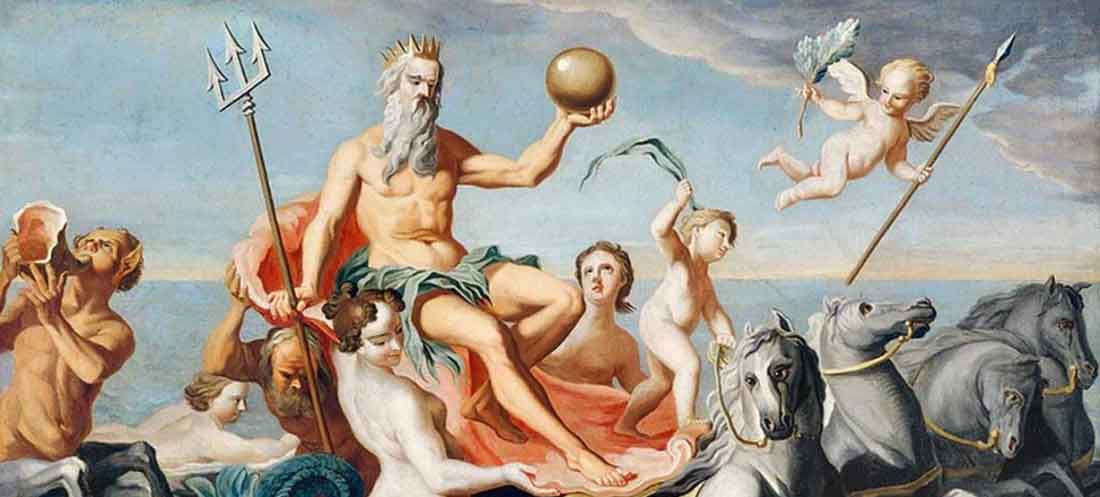Adonis Greek Mythology

When Aphrodite saw him she fell desperately in love, and when he was killed while hunting by a wild boar, she pleaded with Zeus to bring him back to life. Zeus agreed to get the young man back, but he had to stay in the underworld during winter and be with Aphrodite in summer, thus making the vegetation die in winter and blossom in summer.
The cult of Adonis was the first important cult in ancient Greece. It has been suggested that Adonis was a semitic god, since his name seems to be a grecian for of adon – the lord. The myth also resembles the Babylonian story of the god Tammuz death: here, it is Ishtar who laments him and brings him back to the world.
Three goddesses are involved in the child’s life, Aphrodite, Persephone, Artemis. The first, given over to the child’s beauty, handed him over to the second to raise him. But she, in turn, fell in love with the young man and did not want to let him go. Through the mediation of Zeus it was decided that he would spend one third of the time with one goddess, another third with the second and the third with whoever he wanted. Adonis chose to spend the last third with Aphrodite, in total, that is, two thirds of the time.
And as he spent a great part of the time in the upper world, in the fields and forests in company with the Nymphs, hunter and herdsman, there also his death took place. Artemis, enraged for reasons unknown to us, sent a boar against Adonis, which mortally wounded the favored of two gods while hunting. This detail connects the way Adonis was born, at least in one version (the boar tearing the bark of the tree into which his mother had been transformed) with his tusks, with his death.
Other versions blame his death on Ares and the jealousy he felt for Aphrodite’s mortal lover; or Apollo and his anger, because Aphrodite had blinded the son of Erymanthos who had seen her bathing naked. Whatever the cause, the death of her lover Aphrodite (and her association with the sea) associated the goddess with funerary, not just amorous, rites.
Many flower myths were associated with the birth and death of Adonis. First of all the myrrh which is the tears of the mother of Smyrna/Myrrh that was transformed into the tree of the same name. Then, the red roses; dyed red when a thorn wounded her and she bled as she ran to help her injured lover – since then it became the flower dedicated to her by the faithful. The anemones were born from the blood of the wounded Adonis.
Especially the ancient Greek women would worhip Adonis, and womens’ laments were sometimes called Adoniscries. The so-called Adonisgardens were pots with flower seeds in them surrounding a statue of the god. In summer the flowers would grow and in winter wither, symbolizing the myth above.This makes Adonis a god of vegetation as well.
In spring there would be Adonis festivals where wild celebrations of joy would take place, and in autumn there would be mourning processions.
The myth of Adonis was localised and his rites celebrated with much solemnity at two places in Western Asia. One of these was Byblus on the coast of Syria, the other was Paphos in Cyprus
. Both were great seats of the worship of Aphrodite, or rather of her Semitic counterpart, Astarte; and of both, if we accept the legends, Cinyras, (or Theias) the father of Adonis, was king.
Of the two cities Byblus was the more ancient; indeed it is claimed to be the oldest city in Phoenicia, and to have been founded in the early ages of the world by the great god El, whom Greeks and Romans identified with Cronus and Saturn respectively.
One day, whilst out hunting, Adonis was gored by a wild boar and died of his wounds in the arms of a weeping Aphrodite.
The story of Adonis provides the basis of many legends about flowers. The mythical origin of myrrh is said to come from the tears of Myrrh, the red rose is said to have originally been white but turned red from the blood of Aphrodite who pricked her foot on a thorn as she ran to help her wounded lover.
The anemone flower is said to have come about due to the mingling of her tears and his blood as they touched the earth. In honour of Adonis, Aphrodite established a funeral feast, the Adonia festival commemorating his tragic death. This was celebrated each spring by women in Syria and every midsummer by women in Greece.
During this festival, in both countries, women would plant “gardens of Adonis”, small pots containing fast-growing plants, which they would set on top of their houses in the hot sun. The plants would sprout, but soon wither and die. Then the women would mourn the death of Adonis, tearing their clothes and beating their breasts in a public display of grief.
The poet Bion (2nd century, BC) in the poem Adonidos epitaphios gives a poetic correspondence between the blood stains from the wound of Adonis and the tears of the goddess; and even, in the creation of the flowers of the goddess and her mortal lover – as many bloodstains as many tears, as many anemones as many roses. And yet, his close friend and companion Milos was hanged from the tree that took his name, and so was his relative and wife of Milos Pelias, but they were transformed by Aphrodite, Milos into the fruit of the apple tree, and Pelias into a dove .
Beyond the romance of the story, one easily discerns a vegetative myth—the seed that goes under the earth, that is “buried,” that “dies,” as a necessary condition for germination and fruition. after all, the goddess herself established for her beloved a special mourning festival that was celebrated every year in the spring. At that time the women of Syria planted – not in the ground but in jars, containers, etc., so that the vegetation was controlled – seeds that were watered with hot water, so that they would germinate quickly.
But the faster they grew, the faster they died, just as quickly, at a young age, Adonis had died. These were the “gardens of Adonis” over which the women ritually mourned. And in the Phoenician city of Byblos, a festival was established for the death of Adonis; on the day of the mournful festival, the waters of the river of the same name turned red; more natural explanations were given to the phenomenon. However, the placement of the myth in these areas and the fact that in Hebrew Adonai was called the master betrays its eastern origin.
Adonis’s love for the Cypriot daughter Erinona seems to have the same vegetative substance. Many gods and goddesses are involved in their story. The virgins Artemis and Athena, the amorous Aphrodite, in contrast to the first two, the jealous Hera, the amorous Zeus, the soul-stealing Mercury. Erinone and Adonis are the victims of the rivalry of the theans, who clash with each other over their fields of jurisdiction. More specifically:
Athena and Artemis gifted their friendship to the mortal maiden for her wisdom and purity. Angry that the girl did not honor her, Aphrodite tried to make Zeus fall in love with Erinone. Therefore, the involvement of Hera was inevitable and she arranged for Adonis to rape the pure Cypria and lose her virginity, making her indifferent to the Olympian leader.
Enraged, Zeus struck Adonis with a thunderbolt and killed her, while Artemis transformed Erinone into a peacock and then the peacock into a human. As for Adonis, Aphrodite begged Zeus to allow a shadow of the mortal to return to the world of the living led by Mercury. The resurrected Adonis married the transformed and re-transformed Erinone and they had a son, Talos.
Based on the story of Adonis, we can consider that the myth with the love garment has a vegetative and reproductive essence. Erinone’s virginity does not serve life; her transformation from a virgin to a woman with fully developed female potential and finally pregnancy is necessary. Many times in the myth this need takes the form of a violent and involuntary act on the girl and is associated with death, as the daughter must “die” as a daughter and be “born” as a woman; moreover, the seed sinks, is buried in the earth , an act that is a necessary condition for the advent of life.
